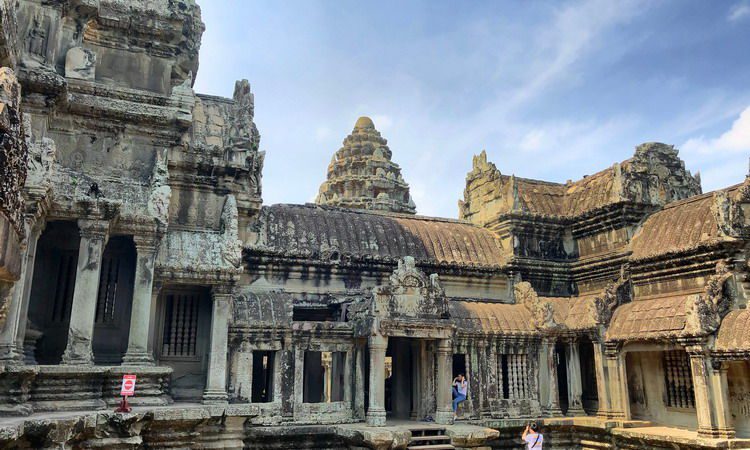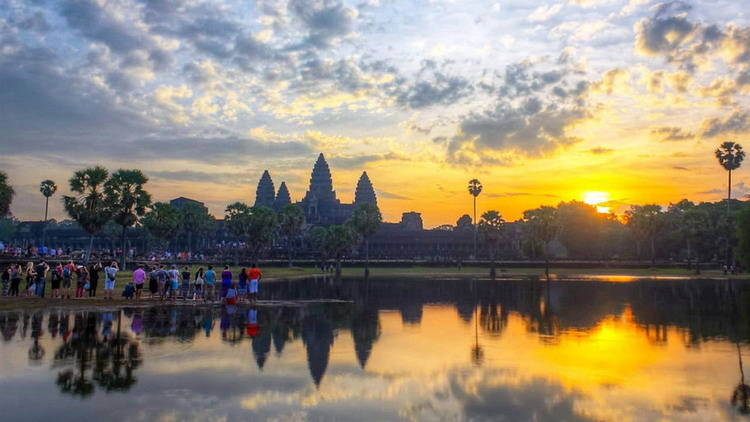Angkor Wat Krong Siem Reap Cambodia
Nestled amidst the lush landscapes of Siem Reap in Cambodia, the iconic Angkor Wat temple stands as a testament to the rich history and architectural brilliance of the Khmer Empire. As the largest religious monument in the world, Angkor Wat is not just a destination; it’s a journey back in time, an exploration of intricate craftsmanship, and an immersion into the spiritual heart of Cambodia.

Angkor Wat
History of the Angkor Wat Krong Siem Seap Cambodia
Angkor Wat, located within the Angkor Archaeological Park, is a UNESCO World Heritage Site that draws travelers from across the globe. Constructed in the 12th century during the reign of King Suryavarman II, the temple was originally dedicated to the Hindu god Vishnu but eventually transformed into a Buddhist site. Its name, “Angkor Wat,” translates to “City of Temples,” reflecting the grandeur and complexity of this ancient marvel.
Architectural of the Angkor Wat KrongTemple
Angkor Wat Krong Temple, located within the Angkor Archaeological Park, is a UNESCO World Heritage Site that draws travelers from across the globe. Constructed in the 12th century during the reign of King Suryavarman II, the temple was originally dedicated to the Hindu god Vishnu but eventually transformed into a Buddhist site. Its name, “Angkor Wat,” translates to “City of Temples,” reflecting the grandeur and complexity of this ancient marvel.

Angkor Wat Temples – Siem Reap
Architectural of the Angkor Wat Temple
The Angkor Wat temple’s architecture is a harmonious blend of intricate design, symbolic significance, and awe-inspiring scale. The central tower, representing the sacred Mount Meru from Hindu cosmology, is surrounded by four smaller towers and a vast moat that symbolizes the cosmic ocean. The temple’s layout reflects the idea of a microcosm of the universe, with its vast courtyards and intricate galleries resembling the cosmos itself.
The bas-reliefs that adorn the walls narrate mythological stories, depict battles, and showcase scenes from daily life during the Khmer Empire. As you walk through the galleries, you’ll encounter intricate carvings that provide insights into the culture, beliefs, and achievements of the time.
Sunrise at Angkor Wat
One of the most iconic experiences at Angkor Wat is witnessing the sunrise over the temple complex. As the first light of dawn breaks, the silhouette of the temple is bathed in hues of gold and orange, creating a surreal and enchanting atmosphere. The reflection of the temple in the surrounding moat adds to the ethereal beauty of the moment. Many travelers gather in the early hours to witness this breathtaking spectacle, making it a serene and shared experience that’s truly magical.

Sunrise at Angkor Wat Temples
Exploring the Temple
Walking through Angkor Wat is like stepping into a living history book. The intricate corridors, steep staircases, and intricately carved galleries invite you to explore its depths. As you ascend the central tower, you’ll be rewarded with panoramic views of the entire complex and the sprawling Angkor Archaeological Park beyond.
The bas-reliefs on the walls are a highlight, telling stories of Hindu epics like the Ramayana and the Mahabharata, as well as showcasing intricate scenes of daily life, dance, and courtly activities. The “Churning of the Ocean of Milk” relief, depicting the mythological tale of the gods and demons churning the ocean to obtain the elixir of immortality, is particularly captivating.
Cultural Significance
Angkor Wat’s importance extends beyond its architectural and historical significance. It holds deep spiritual and cultural meaning for the Cambodian people. Despite being a major tourist attraction, the temple remains a place of active worship and devotion. You’ll often see local visitors lighting incense, making offerings, and engaging in prayer within the temple’s chambers.
Practical Tips when visiting Angkor Wat Krong Siem Reap Cambodia
1. Entry Pass: To explore Angkor Wat and other temples within the complex, you’ll need to purchase an entry pass. There are options for one-day ($37), three-day ($62), and seven-day ($72) passes, allowing you to tailor your visit according to your preferences.
2. Guided Tours: Consider hiring a knowledgeable guide to enrich your experience. They can provide historical context, explain the intricate carvings, and share fascinating stories about the temple.
3. Dress Code: Dress modestly by covering your shoulders and knees as a sign of respect when visiting the temple.
4. Hydration and Comfort: Angkor Wat’s vastness requires a fair amount of walking, so wear comfortable footwear and carry water to stay hydrated, especially in the Cambodian heat.
5. Conservation: Help preserve the temple’s heritage by refraining from touching or leaning on the delicate carvings.
Angkor Wat Krong temple is a cultural treasure that continues to inspire awe and reverence. Its architectural grandeur, historical significance, and spiritual resonance combine to create an unforgettable experience for travelers. As you stand before its towering spires and intricate bas-reliefs, you’ll be transported to a bygone era, where artistry and devotion converged to create one of the world’s most remarkable architectural masterpieces. Siem Reap’s Angkor Wat is not just a destination; it’s a timeless journey through the heart and soul of Cambodia’s past.


